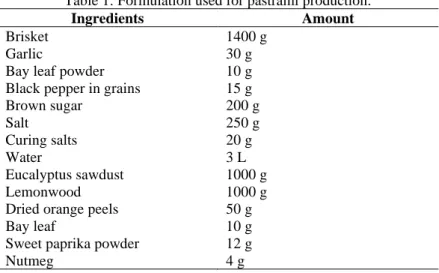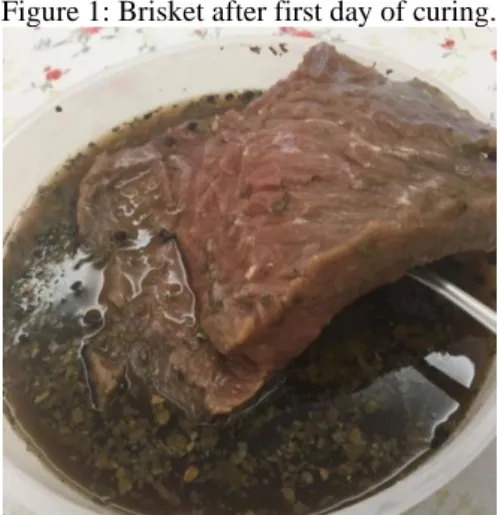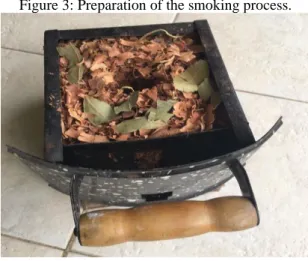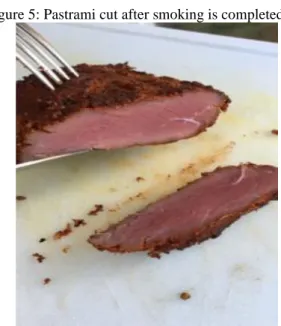Braz. J. of Develop.,Curitiba, v. 6, n. 8, p. 61511-61520 aug. 2020. ISSN 2525-8761
From curing to smoking: processes and techniques for the production of
pastrami
Da cura à defumação: processos e técnicas para a produção de pastrami
DOI:10.34117/bjdv6n8-538
Recebimento dos originais: 08/07/2020 Aceitação para publicação:25/08/2020
Patrick da Silva Cardoso
Bacharelando em Gastronomia pela Universidade Federal da Bahia Instituição: Universidade Federal da Bahia
Endereço: Escola de Nutrição, Universidade Federal da Bahia, Rua Basílio da Gama, S/N, Canela, 40.110-907, Salvador – BA, Brasil
E-mail: patrick.cardoso96@hotmail.com
Juliana Marques Fagundes
Bacharelando em Gastronomia pela Universidade Federal da Bahia Instituição: Universidade Federal da Bahia
Endereço: Escola de Nutrição, Universidade Federal da Bahia, Rua Basílio da Gama, S/N, Canela, 40.110-907, Salvador – BA, Brasil
E-mail: ju.fagundes7@gmail.com
Dayse Santana Couto
Bacharelando em Gastronomia pela Universidade Federal da Bahia Instituição: Universidade Federal da Bahia
Endereço: Escola de Nutrição, Universidade Federal da Bahia, Rua Basílio da Gama, S/N, Canela, 40.110-907, Salvador – BA, Brasil
E-mail: daysegtl@gmail.com
Eduardo de Marchi Pires
Bacharelando em Gastronomia pela Universidade Federal da Bahia Instituição: Universidade Federal da Bahia
Endereço: Escola de Nutrição, Universidade Federal da Bahia, Rua Basílio da Gama, S/N, Canela, 40.110-907, Salvador – BA, Brasil
E-mail: adorose2@hotmail.com
Carlos Eduardo Durão Guimarães
Bacharel em Gastronomia pela Universidade Federal da Bahia Instituição: Centro Estadual de Educação Profissional da Bahia
Endereço: Av. Eng. Oscar Pontes, S/N, Calçada, 40.301-155, Salvador – BA, Brasil E-mail: carlos.durao@yahoo.com.br
Braz. J. of Develop.,Curitiba, v. 6, n. 8, p. 61511-61520 aug. 2020. ISSN 2525-8761
Camila Duarte Ferreira Ribeiro
Doutora em Alimentos, Nutrição e Saúde pela Universidade Federal da Bahia Instituição: Universidade Federal da Bahia
Endereço: Escola de Nutrição, Universidade Federal da Bahia, Rua Basílio da Gama, S/N, Canela, 40.110-907, Salvador – BA, Brasil
E-mail: camiladuartef@ufba.br
Deborah Murowaniecki Otero
Doutora em Engenharia e Ciência de Alimentos pela Universidade Federal do Rio Grande Instituição: Universidade Federal da Bahia
Endereço: Escola de Nutrição, Universidade Federal da Bahia, Rua Basílio da Gama, S/N, Canela, 40.110-907, Salvador – BA, Brasil
E-mail: deborah.otero@ufba.br
ABSTRACT
Since the dawn of humanity, meat has proven to be one of the main sources of food for humans. To increase the durability of this food, several techniques and processes have been developed and improved over time that would allow the best conservation of meat. Among these processes, we can highlight the curing and smoking that, in addition to preserving the food, enhance its organoleptic characteristics, namely: color, aroma, texture, flavor, among others. Given this, the present work aimed to understand how the techniques and processes of meat conservation interfere in the production of pastrami (meat product produced from the brisket). For that, a brisket was subjected to the curing process by brine for 6 days and then subjected to smoking for 4 hours. As a result, was obtained a moist and soft meat, with a pinkish-red color characteristic of cured products. The product also presented the striking smoky flavor and aroma, typical of the product, as recommended in the literature, in addition to the contrast of the color of the interior with the exterior of the product.
Key words: Gastronomy, Food preservation methods, Meat products, Brisket. RESUMO
Desde os primórdios da humanidade, a carne de origem animal tem se mostrado uma das principais fontes de alimentação do ser humano. No intuito de aumentar a durabilidade desse alimento, foram desenvolvidas e aperfeiçoadas, ao longo do tempo, diversas técnicas e processos que permitissem a melhor conservação das carnes. Dentre esses processos, podemos destacar a cura e a defumação que, além de preservar o alimento, aprimoram as suas características organolépticas, a saber: a cor, o aroma, a textura, o sabor, dentre outras. À vista disso, o presente trabalho teve como objetivo compreender de que forma as técnicas e processos de conservação de carnes interferem na produção do pastrami (produto cárneo produzido a partir do peito bovino). Para isso, um peito bovino foi submetido ao processo de cura por salmoura durante o período de 6 dias e, em seguida, submetido a uma defumação durante 4 horas. Como resultado, obtivemos uma carne úmida e macia, com coloração róseo-avermelhada característica dos produtos curados. O produto apresentou ainda o sabor e aroma defumados marcantes, típicos do produto, como preconiza a literatura, além do contraste de coloração do interior com o exterior do produto.
Braz. J. of Develop.,Curitiba, v. 6, n. 8, p. 61511-61520 aug. 2020. ISSN 2525-8761
1 INTRODUCTION
Slaughter and consumption of animals have been carried out by humans since the dawn of humanity. This consumption varies according to the regions and the local habits where these animals come from. Beef meat, for example, very nutritious and rich in proteins, iron and minerals, is widely used in the cuisine of different cultures (COSTA et al, 2015). Given the variety of textures and flavors, in the current literature, there are many ways of preparing this product. Depending on the size of the animal, there are several possibilities of cuts that, in turn, are prepared and cooked in different ways for their best use. Regarding preparation, Montebello and Araújo (2006, p. 169) also state that,
Meat, in addition to being a raw material, is also consumed in the form of meat products, which are products made from the meat of various animals and are alternatives to modify the flavor and increase the durability of these foods. In its preparation, several condiments and some preservatives are used. Many of these are cured, fermented and / or smoked (our translation).1
An example is pastrami, a meat product from Italy that is characterized by being cured and smoked (ARAÚJO, 2013; BEZERRA, 2014) which, according to Montebello and Araújo (2006), is widely consumed by Jews.
Pastrami is produced from beef brisket, a lean meat rich in collagen (PEREIRA, 2015). Because it covers the animal's thoracic bone, called external, the brisket is subject to routine efforts. Therefore, this cut presents harder fibers and a large amount of connective tissue, which requires longer cooking in moist heat to soften the fibers (ARAÚJO et al, 2014). For its acquisition, it is important to observe certain organoleptic characteristics that will guarantee the quality of the product. Among them, the reddish color and the superficial moisture stand out, furthermore to the meat being smooth and not sticky.
For its preparation, is performed in the first instance a curing process, which contributes to the relaxation of muscle fibers, in addition to preventing the growth of bacteria and enhancing the flavor (KÖSEVI, 2010). Subsequently, the product goes through a smoking process, which not only gives it a very characteristic flavor, color and odor but also protects the food against microorganisms (MONTEBELLO AND ARAÚJO, 2006).
Werle and Cox (2008) point out two different styles in the manufacture of pastrami: a) New York style, when cooked dry and having cayenne pepper and black pepper rubbed on the outside,
1 No original: A carne, além de matéria-prima, também é consumida na forma de produtos cárneos, que são produtos
elaborados a partir da carne de diversos animais e se constituem em alternativas para modificar o sabor e ampliar a durabilidade desses alimentos. Na sua preparação, utilizam-se vários condimentos e alguns conservantes. Muitos desses são submetidos à cura, fermentados e/ou defumados.
Braz. J. of Develop.,Curitiba, v. 6, n. 8, p. 61511-61520 aug. 2020. ISSN 2525-8761
making the meat very spicy, and b) American style, also rubbed with cayenne pepper and black pepper, but with a milder flavor to the detriment of New York style pastrami.
In view of the little information about pastrami in the current literature and the prominence that this meat product has received in recent years, its study is pertinent. Thus, the present work aimed to understand, both in theory and in practice, how these food preservation processes interfere in the production of pastrami.
2 MATERIALS AND METHODS
Taking into account the research related to the theme, a test was carried out to use the conservation processes to produce pastrami.
The brisket, along with the other ingredients used, was purchased in local stores in the city of Salvador - Bahia. Table 1 describes the ingredients and their respective weights.
Table 1: Formulation used for pastrami production.
Ingredients Amount
Brisket 1400 g
Garlic 30 g
Bay leaf powder 10 g
Black pepper in grains 15 g
Brown sugar 200 g Salt 250 g Curing salts 20 g Water 3 L Eucalyptus sawdust 1000 g Lemonwood 1000 g
Dried orange peels 50 g
Bay leaf 10 g
Sweet paprika powder 12 g
Nutmeg 4 g
To avoid the dehydrating effects of salt in dry curing, the brining technique used in brisket was added with curing salts. The curing salts and salt were dissolved in 3 liters of water and then crushed garlic, powdered bay leaf, black pepper and brown sugar were added. The meat was immersed in this mixture for 6 days, in a plastic container, refrigerated in a domestic refrigerator.
At the end of the curing process, the meat was washed under running water and dried with disposable paper towels. The sweet paprika powder was also added to the cured and dried brisket, seeking to reproduce what the literature prescribed. Afterward, the product was subjected to the smoking process, carried out on an aluminum-type barbecue grill, for 4 hours. For its realization, eucalyptus sawdust, lemonwood, dried orange peels, bay leaves and nutmeg were used as smoke sources.
Braz. J. of Develop.,Curitiba, v. 6, n. 8, p. 61511-61520 aug. 2020. ISSN 2525-8761
3 RESULTS AND DISCUSSION
During the brine curing process, osmosis occurred, in which the internal fluids of the cells cross the membrane to decrease the salt concentration from the outside until reaching osmotic balance. However, as the concentration of liquid on the outside was greater than on the inside, the reverse process was verified, bringing salt into the cell, which leads to the inhibition of the growth of pathogenic agents (PEREIRA, 2015; SÃO PAULO, 1999, GARDE MANGER, 2014).
The brine also has the advantage of being more effective in the distribution of spices, because all the meat absorbs them equally, adding more flavor to the preparation and increasing the moisture inside the product (CARVALHO, 2014; BRASIL, 1997).
In addition to protecting from deterioration, the salt contributed to the appearance and texture of the final product, because the high concentration of salt causes the protein filaments of the muscle cells to separate, weakening the fibers and making the tissue more dense and concentrated, resulting in a softer texture (MCGEE, 2014). This change in volume can be seen in Figures 1 and 2.
Figure 1: Brisket after first day of curing.
Braz. J. of Develop.,Curitiba, v. 6, n. 8, p. 61511-61520 aug. 2020. ISSN 2525-8761
Because not only salt was used, but also nitrite and nitrate (curing salts), sugar and some spices, ingredients that alter physical and chemical characteristics (PEREIRA, 2015; SÃO PAULO, 1999), sensory modifications, such as changes in texture, color and odor of the product, were observed.
Damodaran et al (2010, p. 749, our translation) affirm that “the main curing agents today are nitrite (NO-2) and nitrate (NO-3) [...] allowing for slow curing reactions that must produce a better flavor and a more stable color ”2 while McGee (2014) points out that nitrite plays several important roles in curing meat, such as contributing to its flavor, spicy and pungent and reacting in the meat to form nitric oxide (NO), which slows down the development of rancid flavors in fat.
Besides, the main visual characteristic of cured products is also conferred by this substance, since its presence produces the characteristic pinkish-red color of cured meat. Finally, nitrite suppresses the growth of various bacteria, especially the spores of bacteria intolerant to oxygen that cause botulism (MCGEE, 2014).
However, the use of curing salts is strictly controlled, since, in the presence of excessive heat, they are decomposed and form nitrosamines, carcinogens. Despite this, its absence would represent more serious risks due to the significant increase in cases of botulism (GARDE MANGER, 2014).
Sugar was also used to help reduce the potential of hydrogen (pH) and consequently increase the acidity of the product (MCGEE, 2014). In addition, sugar also gave a sweet taste, providing a sweet vs. salty combination and softening the flavor of spices, condiments and the very taste of salt and healing salt (ARAÚJO et al, 2014).
After the curing period in brine, the brisket was washed and dried, following the recommendations of Carvalho (2014, p. 50) when warning that “you should never put the meat to smoke wet, because in this process it must lose moisture and if it is wet, the smoking time will be longer than expected, impairing the final flavor and texture of the product3” (our translation).
That done, the second process applied to the brisket was smoking, made from the smoke obtained from the burning of vegetable matter, also used for the conservation of the product. This process assists in preservation by having compounds that destroy microorganisms or inhibit their development. It is still widely used because it has compounds that prevent the perception of rancid
2 No original: Os principais agentes de cura, hoje, são o nitrito (NO-2) e o nitrato (NO-3) [...] permitindo reações lentas
de cura que devem produzir um sabor melhor e uma coloração mais estável.
3 No original: Nunca se deve colocar a carne para defumar molhada, pois nesse processo ela deve perder umidade e se
estiver molhada o tempo de defumação será mais longo do que o esperado, prejudicando o sabor e a textura final do produto.
Braz. J. of Develop.,Curitiba, v. 6, n. 8, p. 61511-61520 aug. 2020. ISSN 2525-8761
flavor, very present in salty meats, susceptible to rancidity (PEREIRA, 2015). This is because, during smoking, volatile compounds are produced that also add flavor and aroma to the food (ARAÚJO et al, 2014).
The added flavor may vary according to the type of wood that was used and the spices added in the curing of the product. The flavor from smoking can be intensified through the time the product has been exposed to smoke (KÖVESI, 2010), which, in this case, was 4 hours. However, smoke affects only the surface and is therefore used with curing in food conservation.
Smoking also affected the color of the food due to the reaction of carbonyl present in the smoke, which presents a color range from golden yellow to dark brown. When exposed to heat and smoke, the meat dehydrated and superficially dried, promoting the formation of physical-chemical barriers against contamination by microorganisms (MCGEE, 2014).
Lemonwood and eucalyptus sawdust were used thinking about the flavor to be added, since, as prescribed by Montebello and Araújo (2016, p. 172) “some woods are contraindicated because they give a bitter taste”. The literature points out that the woods of fruit trees such as apple trees, orange trees and guava trees are the most recommended. It is worth mentioning that, in the absence of these specific woods, smoking can be carried out with other types, if the absence of natural resins possibly present in the chosen wood is observed.
Finally, in smoking, bay leaves, orange peels and nutmeg were also used, as both spices and aromatic herbs add depth of flavor to the smoked food (CARVALHO, 2014). The smoking process can be seen in Figures 3 and 4.
Braz. J. of Develop.,Curitiba, v. 6, n. 8, p. 61511-61520 aug. 2020. ISSN 2525-8761
Figure 4: Brisket submitted to smoking process on a barbecue grill.
As a final result, was obtained a moist and soft meat, since, despite being a curing process, the use of brine raised the moisture inside the product. Furthermore to helping in the process of softening the fibers, due to the presence of lactic acid resulting from brown sugar fermentation, and in the flavor distribution of spices.
Due to the presence of curing salts, which favor color stability, the pinkish-red coloration characteristic of cured products was obtained. The product also presented the distinctive smoky flavor and aroma, typical of the product, as recommended in the literature. The smoking process also provided a contrast between the inside and outside of the product, since the outside was exposed to the carbonyl present in the smoke, presenting a dark brown color. This contrast can be seen in Figure 5.
Braz. J. of Develop.,Curitiba, v. 6, n. 8, p. 61511-61520 aug. 2020. ISSN 2525-8761
4 CONCLUSION
Despite the few analyzes on this theme present in the current literature, it was possible to carry out, as a test, the production of a meat product of the pastrami type.
Therefore, the research was satisfactory when reaching out, as a final product, a pastrami presenting the physical characteristics portrayed in the literature, that is, a meat product with the characteristic pink internal color and the contrast with the external color, together with the aroma of the product smoked and the fibers softened.
Finally, techniques for the conservation and organoleptic improvement of the meat product is necessary for future research through microbiological analysis during the production of pastrami.
Braz. J. of Develop.,Curitiba, v. 6, n. 8, p. 61511-61520 aug. 2020. ISSN 2525-8761
REFERENCES
ARAUJO, R. V. Os saberes gastronômicos e a formação de chefes: o itinerário acadêmico-profissional de gastrônomos que atuam em Fortaleza-CE. 2013. 82f. Dissertação (Mestrado em Educação Brasileira) – Faculdade de Educação, Universidade Federal do Ceará, Fortaleza, 2013.
ARAÚJ O, W. M. C .; MONTEB ELLO, N. di P.; BOTELHO, R. B. A.; B ORGO, L. A. Alquimi a dos Ali ment os . 3. Ed. B rasíl ia: Edit ora S ENAC -DF, 2014.
BARRETO, R. P . L. Pass aport e para o sabor: t ecnol ogi as para elaboração de cardápios . 8ª Ed. S ão Paul o: Edit ora S ENAC - SP, 2010.
BEZERRA, J. A. B. Alimentos tradicionais do Nordeste: Ceará e Piauí. 1. ed. Fortaleza: Edições UFC, 2014. v. 1. 119p.
BRASIL. Portaria nº. 451, de 19 de setembro de 1997. Princípios gerais para o estabelecimento de critérios e padrões microbiológicos para alimentos. Diário Oficial [da] República Federativa do Brasil, Brasília, DF, 22 set. 1997. Seção 1, n. 182, p. 21005-21011.
CARVALHO, R. Cozinha Fria: da ornamentação à execução do cardápio. 1ª Ed. São Paulo: Érica / Saraiva, 2014.
COSTA, P. R.; SIQUEIRA, A. C. P.; SOUSA, P. H. M. Efeito do procedimento culinário e conservação por congelamento em tomates (Lycopersicum esculentum). Arq. Bras. Alim. 1, 30-42, 2015.
DAMODARAN, S.; PARKIN, K.; FENNEMA, O. Química de alimentos de Fennema. 4ª Ed. Porto Alegre: Artmed, 2010.
GAR DE MANGER/ Insti tuto Ameri cano de Culi nári a. Garde Manger: a arte e o ofí cio da cozinha fri a. 4ª Ed. S ão Paulo: SENAC - SP, 2014.
KÖVESI, B.; SIFFERT, C.; CREMA, C.; MARTINOLI, G. 400g – Técnicas de cozinha. 1ª Ed. 3ª reimpressão. São Paulo: Editora Nacional, 2010.
MCGEE, H. C omida & Cozinha: ci enci a e cultura da culinári a . 2ª Ed. S ão P aul o: Editora WM F Mantins Font es , 2014.
MONTEBELLO, N.; ARAÚJO, W. Carne & cia. Volume 1. Brasilia: Editora SENAC – DF. 2006.
PEREIRA, C. P.; SOUSA, P. H. M.; MAIA, C. S. C.; FIGUEIREDO, R. W.; LIMA, A. C. S. Avaliação do método de cocção mais eficiente para retenção de polifenóis totais e antioxidantes de beterraba (Beta vulgaris L.). In: Emmanuel Prata de Souza; Francisca Noélia Pereira Mendes; Maria Marlene Marques Ávila. (Org.). Ciência da nutrição e campos multidisciplinares de saberes. 1ed. Fortaleza: Ed UECE, 2015, v. 1, p. 95-119.
SÃO PAULO (Estado). Secretaria do Meio Ambiente. Tratados e organizações ambientais em matéria de meio ambiente. In: SÃO PAULO (Estado). Entendendo o meio ambiente. São Paulo, 1999. Disponível em: Acesso em: 8 mar. 1999.



